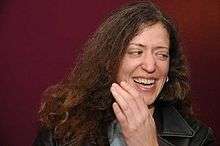Rachel Wetzsteon
| Rachel Wetzsteon | |
|---|---|
 | |
| Born |
November 25, 1967 New York City |
| Died |
December 25, 2009 (aged 42) New York City |
| Nationality | American |
| Alma mater | Johns Hopkins University; Columbia University |
| Genre | Poetry |
Rachel Todd Wetzsteon (November 25, 1967 – December 24/25?, 2009) was an American poet.[1]
Life
Born in New York City, New York, the daughter of editor Ross Wetzsteon (the name is pronounced "whetstone"),[2] she graduated from Yale University in 1989 where she studied with Marie Borroff and John Hollander. She graduated from Johns Hopkins University with an MA, and from Columbia University with a Ph.D. She taught at Barnard College.
She lived in Manhattan and went on to teach at William Paterson University[3] and the Unterberg Poetry Center of the Ninety-Second Street Y.
Her work appeared in many publications including The New Yorker,[4] The Paris Review, The New Republic,[5] The Nation,[6] and The Village Voice.[7] She was poetry editor of The New Republic.
Wetzsteon committed suicide on Dec. 24 or early on the 25th, 2009.[2][8] Since 2010, a writing prize has been offered in her memory in the Columbia University English Department.[9]
Awards
- 2001 Witter Bynner Poetry Prize from the American Academy of Arts and Letters
- Ingram Merrill grant
- 1993 National Poetry Series, for Other Stars
Works
- "Gold Leaves"; "Five-Finger Exercise", THE CORTLAND REVIEW, ISSUE 32, June 2006
- "At the Zen Mountain Monastery", Very Like a Whale, September 7, 2006
- "Pemberley". The Nation. October 3, 2002.
- "Manhattan Triptych"; "Sakura Park", Poetry Daily
Poetry
- The Other Stars (Penguin, 1994) ISBN 978-0-14-058728-9
- Home and Away (Penguin, 1998) ISBN 978-0-14-058892-7
- Sakura Park (Persea, 2006) ISBN 978-0-89255-324-2
- Silver Roses (Persea, 2010)
Anthologies
- Mark Jarman and David Mason, eds. (1996). Rebel Angels: 25 Poets of the New Formalism. Story Line Press. ISBN 1-885266-30-8
- Gerald Costanzo and Jim Daniels, eds. (2000). American Poetry: The Next Generation. Carnegie Mellon University Press. ISBN 978-0-88748-337-0
- J. D. McClatchy, ed. (2001). "Commands for the End of Summer; Blue Octavo Haiku; And This Time I Mean It". Bright pages: Yale writers 1701-2001. Yale University Press. ISBN 978-0-300-08944-8.
Criticism
- "Some Reflections on Eliot's "Reflections on Vers Libre": on Verse and Free Verse". poets.org.
- "Rachel Wetzsteon on Auden", NEWSLETTER 21, The W. H. Auden Society, February 2001
- Influential Ghosts: A Study of Auden's Sources. Routledge. 2005. ISBN 978-0-415-97546-9. (reprint CRC Press, 2007)
- "Ruskin's Whip". Parnassus. January 1, 2005.
- "Marvellous Sapphics", Poetry Society: "Crossroads", Fall 1999
Editor
- Virginia Woolf, Night and Day (Barnes and Noble Classics, 2005)
- The Collected Poems of Emily Dickinson. Barnes and Noble Classics. 2003. ISBN 978-1-56619-030-5.
Reviews
In a perfect world, Rachel Wetzsteon would be one of the most popular poets of her generation. You would see people in the outdoor cafes along Upper Broadway reading copies of Sakura Park, her third collection, the way pilgrims to Greenwich Village carry Scott Fitzgerald or Edna St. Vincent Millay. For Wetzsteon's poems manage to turn Morningside Heights—a quiet, bourgeois neighborhood near Columbia University, home to the park of her title—into a theater of romance, an intellectual haven, a flaneur's paradise. Her poems evoke the kind of life that generations of young people have come to New York to live—earnest, glamorous, and passionate, full of sex and articulate suffering...[10]
Rachel Wetzsteon’s inheritance from W.H. Auden (she’s the author of Influential Ghosts: A Study of Auden’s Sources) is nowhere more apparent than in her third collection. Just as in Auden’s “Musée des Beaux Arts,” where life goes on as Icarus plunges into the sea, Wetzsteon has set a tale of personal heartbreak against the bustling, vivid life of New York City.[11]
References
- ↑ "Poet Rachel Wetzseon To Read - Amherst College". amherst.edu.
- 1 2 Margalit Fox (December 31, 2009). "Rachel Wetzsteon, Poet of Keen Insights and Wit, Dies at 42". The New York Times.
- ↑ http://euphrates.wpunj.edu/faculty/parrasj/EngDeptWebpageEUPHRATES/Faculty.htm
- ↑ The New Yorker. "The New Yorker". The New Yorker.
- ↑ The New Republic. "From "Thirty-Three"". The New Republic.
- ↑ "October 21, 2002". thenation.com.
- ↑ "Rachel Wetzsteon - New York - Village Voice". villagevoice.com.
- ↑ Adam Kirsch (December 30, 2009). "In Memory, and Admiration, of Rachel Wetzsteon". The New Republic.
- ↑ "DEPARTMENTAL & RELATED EVENTS", Columbia University
- ↑ Adam Kirsch. "Young Poets Calling: Part 3". Contemporary Poetry Review.
- ↑ "Microreviews: Sakura Park", Boston Review, Amy Newlove Schroeder, MARCH/APRIL 2008
External links
- "Rachel Wetzsteon, Poet of Keen Insights and Wit, Dies at 42", New York Times, December 31, 2009
- "Rachel Wetzsteon, poet mixed melancholy, wit", Boston Globe, January 2, 2010
- "RIP Rachel Wetzsteon", Avoiding the Muse
- "RIP Rachel Wetzsteon (1967-2009)", Pugnacious Pinoy
- "E-Verse is deeply saddened by the death of the poet Rachel Wetzsteon", E-Verse Radio
- "Rachel Wetzsteon dead", Eratosphere
- "Remembering Rachel Wetzsteon", The Best American Poetry, January 8, 2010
- Rachel Wetzsteon 1967 - 2009 This "cyber-tombeau" at Silliman's Blog by poet Ron Silliman includes comments, tributes, and links
- "Home and Away." The Paris Review sessions, Issue 143, Summer 1997
- "A Sad Goobye to Rachel Wetzsteon", The Drabbler, January 28, 2010